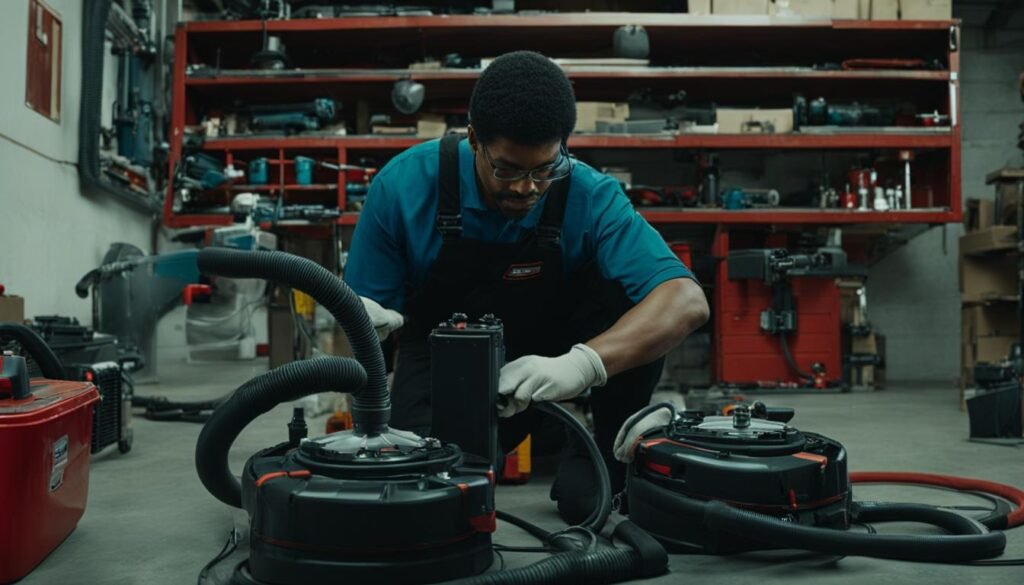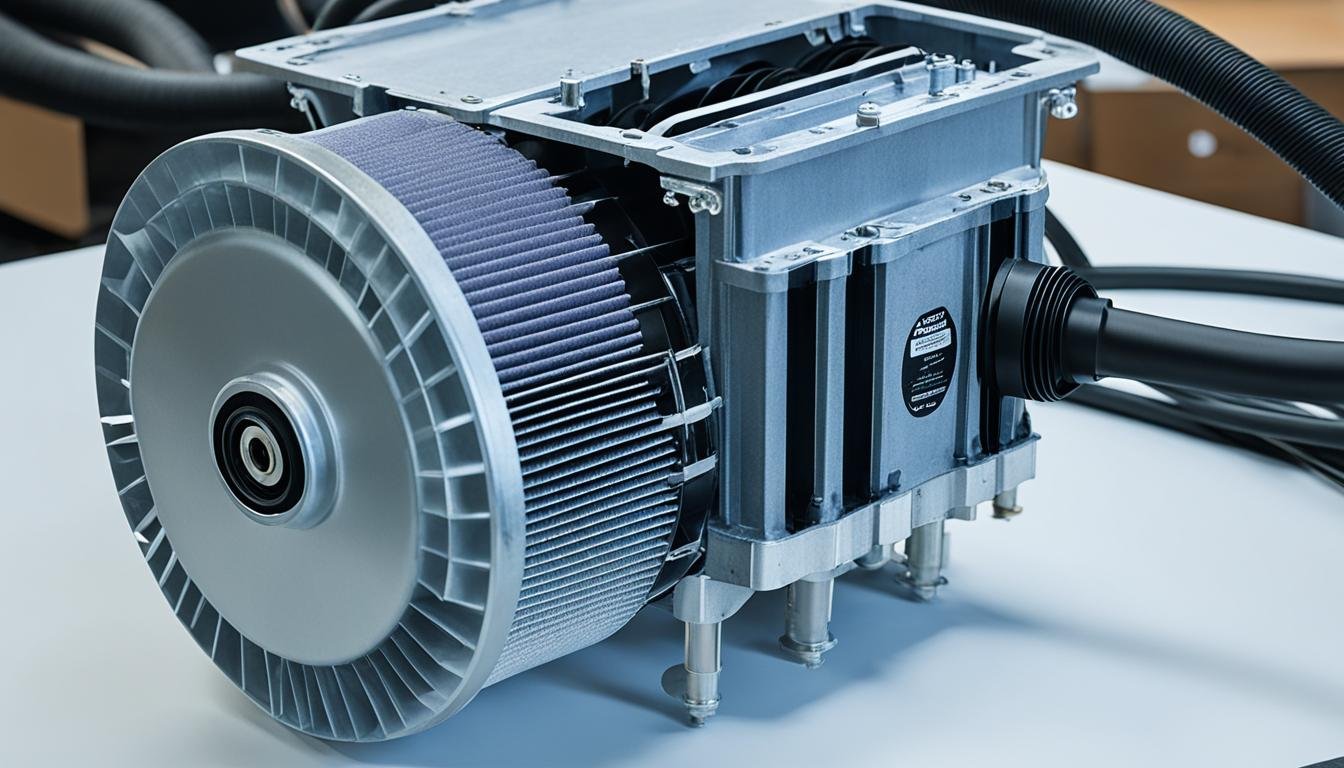If you’re looking to create your own industrial vacuum cleaner, you’ve come to the right place! Building your own DIY industrial vacuum cleaner can be a fun and rewarding project that allows you to customize the machine according to your specific needs. Whether you’re a cleaning enthusiast or someone who wants to tackle tough cleaning tasks in a commercial or industrial setting, this step-by-step guide will walk you through the process of building your own industrial vacuum cleaner.
Key Takeaways:
- Building an industrial vacuum cleaner requires careful planning and attention to detail
- Key components of an industrial vacuum cleaner include the motor unit, filter chamber, collection container, silenced exhaust, suction nozzle, and control panel
- Choose the right motor and filtration system based on your specific cleaning needs
- Consider factors such as collection capacity, noise reduction, and safety
- Ensure that your DIY industrial vacuum cleaner meets all necessary standards and regulations
Components of an Industrial Vacuum Cleaner
An industrial vacuum cleaner consists of several essential components that work together to provide efficient cleaning performance. Understanding these components and their functions is crucial for anyone interested in assembling or maintaining an industrial vacuum cleaner.
The Motor Unit
The motor unit is the heart of an industrial vacuum cleaner. It can be either a side channel blower or a centrifugal fan, depending on the desired performance and the nature of the suctioned materials. The motor unit generates the necessary suction power to remove dirt and debris effectively. Proper selection of the motor unit is essential to ensure optimal performance.
The Filter Chamber
The filter chamber houses the main filter of the industrial vacuum cleaner. This filter is designed to capture even the smallest particles, ensuring a clean and healthy working environment. It effectively prevents the released air from containing fine dust or allergens that could be harmful to operators or the surroundings. Regular maintenance and periodic cleaning of the filter are crucial to maintain the vacuum cleaner’s efficiency.
The Collection Container with Release Lever
The collection container is where the suctioned material is collected, and it can be customized based on specific needs. It typically features a release lever that allows for easy emptying of the collected debris. The capacity of the collection container should be chosen based on the volume of material expected during cleaning operations.
Silenced Exhaust
The silenced exhaust is an important feature of an industrial vacuum cleaner, as it helps reduce the noise generated during operation. This is achieved through the implementation of noise reduction measures that minimize the sound produced by the movement of air within the vacuum cleaner. A quieter vacuum cleaner enhances the overall working environment.
Suction Nozzle for Hose Connection
The suction nozzle is the inlet point where the suction hose attaches to the vacuum cleaner body. It is designed to provide a secure and efficient connection, ensuring optimal suction performance. The suction nozzle plays a crucial role in capturing debris efficiently and preventing any loss of suction power.
Control Panel
The control panel is used to operate the industrial vacuum cleaner and offers various functions and features. Depending on the model and manufacturer, the control panel can include options such as filter cleaning mechanisms, scheduling functionalities, and performance adjustments. The control panel allows operators to customize the vacuum cleaner’s operation and ensure its optimal performance.
Understanding the components of an industrial vacuum cleaner is essential for anyone involved in its assembly, maintenance, or troubleshooting. With the right combination of these components, an industrial vacuum cleaner can provide efficient and effective cleaning performance for various commercial and industrial applications.
Tips for Building an Industrial Vacuum Cleaner
Building an industrial vacuum cleaner requires careful planning and attention to detail. To create a DIY industrial vacuum cleaner that meets your specific cleaning needs, follow these step-by-step tips:
- Identify your specific cleaning needs: Determine the type of materials you’ll be suctioning and the level of performance required for your vacuum cleaner. This will help you choose the appropriate components and design.
- Research different types of motors and filters: Evaluate the various options available to you based on factors such as suction power, energy efficiency, and durability. Select the motor and filter that are best suited for your application.
- Consider the capacity of the collection container: Determine the size of the container based on the amount of material you’ll be collecting in one cleaning session. If continuous discharge is necessary for your cleaning process, ensure that it is accommodated in the design.
- Ensure proper ventilation and noise reduction measures: Good ventilation is essential to prevent overheating of the motor and maintain optimal performance. Implement noise reduction measures, such as adding sound insulation materials, to minimize noise levels during operation.
- Follow safety guidelines: When building your industrial vacuum cleaner, prioritize safety. Ensure that all electrical connections are properly insulated and grounded. Use appropriate safety switches and circuits to prevent accidents. Adhere to relevant standards and regulations to ensure the safe use of your DIY vacuum cleaner.
By following these tips, you can successfully build a homemade industrial vacuum cleaner that meets your specific cleaning requirements. Remember to consider factors such as motor performance, filtration, collection capacity, noise reduction, and safety to create an efficient and effective cleaning solution.
Quote:
“Building an industrial vacuum cleaner is a rewarding project that allows you to customize the machine according to your needs. By carefully planning and paying attention to the details, you can construct a powerful and efficient cleaning tool.” – Eric Johnson, DIY Enthusiast

| Advantages | Disadvantages |
|---|---|
| Economical option | Requires technical knowledge and skills |
| Customizable design | No manufacturer warranty |
| Potential for cost savings | May take time and effort to source components |
| Ability to create a specialized cleaning solution | No professional support or maintenance |
Conclusion
Building your own industrial vacuum cleaner can be a rewarding and cost-effective alternative to purchasing one. By following the step-by-step tutorial and understanding the key components required, you can create a customized machine that meets your specific cleaning needs.
Remember to consider factors such as motor performance, filtration efficiency, collection capacity, noise reduction, and safety precautions. These elements are crucial to ensure the efficiency and effectiveness of your DIY industrial vacuum cleaner.
With the right tools, knowledge, and attention to detail, you can successfully construct an industrial vacuum cleaner that rivals commercially available models. Enjoy the satisfaction of a job well done while saving money and having a powerful cleaning tool at your disposal.
FAQ
What are the key components of an industrial vacuum cleaner?
The key components of an industrial vacuum cleaner include the motor unit, filter chamber, collection container with release lever, silenced exhaust, suction nozzle for hose connection, and control panel.
What is the function of the motor unit in an industrial vacuum cleaner?
The motor unit is the heart of an industrial vacuum cleaner and can be either a side channel blower or centrifugal fan. It provides the suction power needed to clean effectively.
Why is the filter chamber important in an industrial vacuum cleaner?
The filter chamber houses the main filter, which ensures that even the smallest particles are retained and helps maintain a clean working environment.
What is the purpose of the collection container with a release lever?
The collection container is used to collect the suctioned material, and the release lever makes it easy to empty the container when it gets full.
How does the silenced exhaust contribute to an industrial vacuum cleaner?
The silenced exhaust helps reduce the noise generated by the movement of air within the vacuum cleaner, creating a quieter working environment.
What role does the suction nozzle for hose connection play in an industrial vacuum cleaner?
The suction nozzle is the inlet point where the suction hose attaches to the vacuum cleaner body, allowing for effective suction and cleaning.
How does the control panel in the vacuum cleaner work?
The control panel is used to operate the vacuum cleaner and may include functions such as filter cleaning and scheduling, making it easier to manage and maintain the machine.
What factors should I consider when building an industrial vacuum cleaner?
When building an industrial vacuum cleaner, it’s important to consider factors such as motor performance, filtration capabilities, collection capacity, noise reduction measures, and safety requirements.
Can I customize my DIY industrial vacuum cleaner to suit my specific needs?
Yes, building your own industrial vacuum cleaner allows you to customize the machine according to your specific cleaning needs, ensuring it meets your requirements and preferences.
Are there any safety guidelines I should follow when building an industrial vacuum cleaner?
Absolutely, it’s essential to follow safety guidelines when building an industrial vacuum cleaner to prevent accidents or injuries. Additionally, make sure your DIY machine complies with all necessary standards and regulations.






Leave a Reply